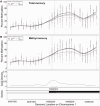Prenatal mercury concentration is associated with changes in DNA methylation at TCEANC2 in newborns
- PMID: 25906783
- PMCID: PMC4588863
- DOI: 10.1093/ije/dyv032
Prenatal mercury concentration is associated with changes in DNA methylation at TCEANC2 in newborns
Abstract
Background: Human exposure to the widespread environmental contaminant mercury is a known risk factor for common diseases such as cancer, cardiovascular disease and neurological disorders through poorly characterized mechanisms. Evidence suggests mercury exposure may alter DNA methylation levels, but to date, the effects in early life on a genome-wide scale have not been investigated.
Methods: A study sample of 141 newborns was recruited in Baltimore, MD, USA and total mercury and methylmercury were measured in cord blood samples. We quantified genome-wide DNA methylation data using CHARM 2.0, an array-based method, and used region-finding analyses to identify concentration-associated differentially methylated regions (DMRs). To test for replication of these identified DMRs in the pilot, or Vanguard, phase of the National Children's Study (NCS), we compared bisulfite-pyrosequenced DNA at candidate regions from 85 whole cord blood samples with matched first trimester maternal mercury concentration measures.
Results: Total mercury concentration was associated with methylation at DMRs inside ANGPT2 and near PRPF18 genes [false discovery rate (FDR) < 0.05], as well as DMRs near FOXD2 and within TCEANC2 (FDR< 0.1) genes. Methylmercury concentration was associated with an overlapping DMR within TCEANC2 (FDR< 0.05). In NCS replication analyses, methylation levels at three of four cytosine-guanine DNA dinucleotides (CpG sites) within the TCEANC2 DMR were associated with total mercury concentration (P < 0.05), and this association was diminished after adjusting for estimated cell proportions.
Conclusions: Evidence for an association between mercury and DNA methylation at the TCEANC2 region was found, which may represent a mercury-associated shift in cord blood cell composition or a change in methylation within blood cell types. Further confirmatory studies are needed.
Keywords: DNA methylation; cord blood; epigenetics; mercury exposure; methylmercury.
© The Author 2015; all rights reserved. Published by Oxford University Press on behalf of the International Epidemiological Association.
Figures


References
-
- Counter SA, Buchanan LH. Mercury exposure in children: a review. Toxicol Appl Pharmacol 2004;198:209–30. - PubMed
-
- World Health Organization. Children’s Exposure to Mercury Compounds. Geneva:WHO, 2010.
-
- Social Scientific Study Group on Minamata Disease. In the Hope of Avoiding Repetition of Tragedy of Minamata Disease. 1999. http://www.nimd.go.jp/syakai/webversion/SSSGMDreport.html (8 July 2010, date last accessed).
Publication types
MeSH terms
Substances
Grants and funding
- HHSN275200503415C/PHS HHS/United States
- HHSN275200603416C/PHS HHS/United States
- P30 CA006973/CA/NCI NIH HHS/United States
- HHSN275200900010C/PHS HHS/United States
- HHSN275200503411C/PHS HHS/United States
- ES017646/ES/NIEHS NIH HHS/United States
- HHSN27520080033C/PHS HHS/United States
- R01 ES017646/ES/NIEHS NIH HHS/United States
- HHSN275200503410C/PHS HHS/United States
- HHSN275200503413C/PHS HHS/United States
- HHSN275200503396C/PHS HHS/United States
- HHSN275200503414C/PHS HHS/United States
- HHSN275201000121U/PHS HHS/United States
- P30 ES009089/ES/NIEHS NIH HHS/United States
LinkOut - more resources
Full Text Sources
Other Literature Sources
Medical

